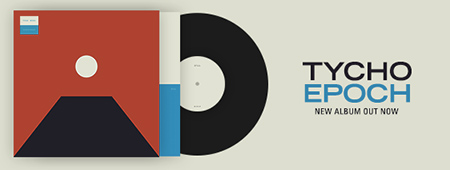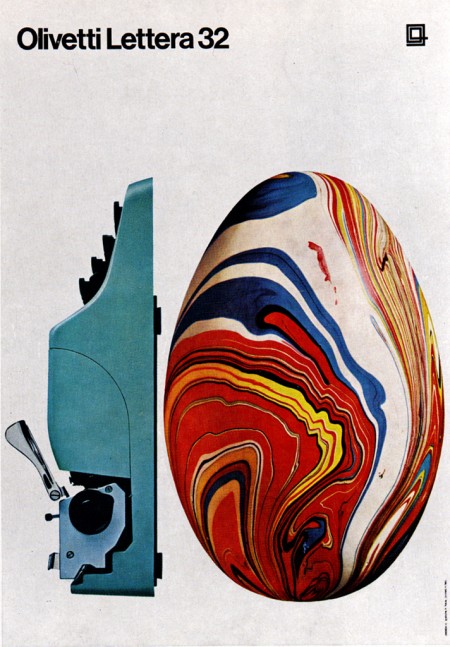
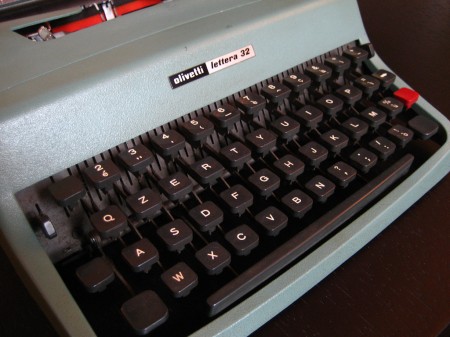
“The Olivetti Lettera 32 is a portable mechanical typewriter designed by Marcello Nizzoli for Olivetti in 1963 as the successor of the popular Olivetti Lettera 22. This typewriter was popular amongst journalists and students.
The typewriter is sized about 34x35x10 cm (with the carriage return lever adding about 1-2 more centimeters in height), making it portable at least for the time’s standards, even though its 5.9 kg weight may limit portability somewhat.”
– Wikipedia
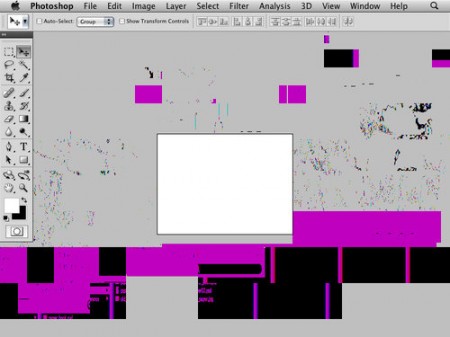
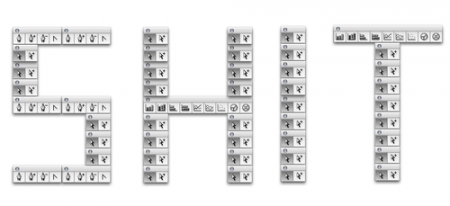
A friend that I used to work at Adobe with sent me this Adobe UI Gripes site yesterday. I really can’t say why I find it so amusing but maybe it’s just nice to see someone going through the same frustration I feel sometimes with Adobe apps. I guess when you’ve essentially monopolized the creative software market like Adobe, you make a pretty easy target for stuff like this. Anyways, it’s a fun read and there are gems like this sprinkled around here and there. I’ve encountered a lot of these before and just asked why, but I’m not sure I ever got as worked up as this. Link
Realistically, I really only have a few problems with CS4. At the top of the list would be Bridge. Somewhere around CS3 Adobe decided to cripple Windows machines and remove the thumbnail icon viewing capability from the OS file explorer thereby forcing you to use Bridge (pretty clever). This wouldn’t be a big deal, I actually like Bridge a lot, only problem is it crashes nearly every time I use it for more than 10 minutes. There’s a fix for 32-bit windows installs but not for 64-bit so we’re left with the generic icon when trying to browse PSD’s in explorer. A couple others would be the permanent hand icon mode (you’ll know it if you’ve encountered it…thankfully there’s any easy fix: reset warning dialogs, but why?) and the delay in dragging content from one tabbed window in Photoshop to another tabbed document, you have to hold that thing up there for waaay too long. How about you, what Adobe bugs do you love to hate?
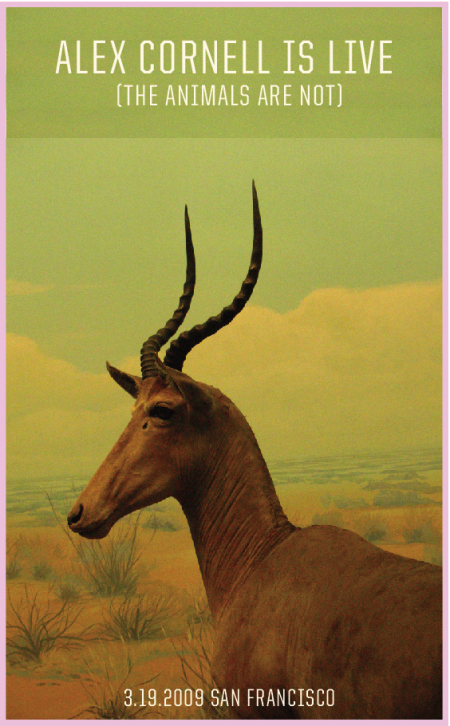
Our very own Alex Cornell designed this poster for the live 2 hour solo acoustic set he’ll be playing this Thursday at the California Academy of Science in Golden Gate Park, San Francisco. Be there! His set is part of the Nightlife series featuring a lecture by WIRED magazine.
Edit: Unfortunately, it looks like it’s sold out.
Edit #2: Apparently there are tickets to be had at the door. Just make sure to show up a bit early…
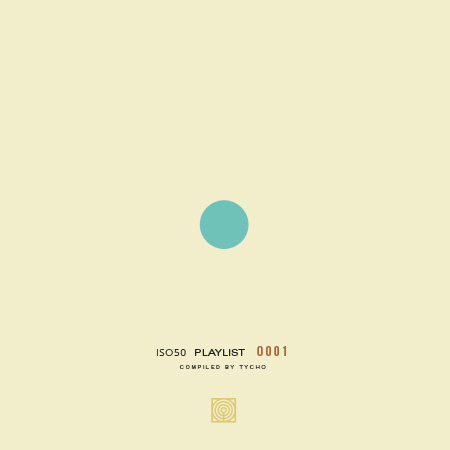
Track Listing:
School Of Seven Bells – Half Asleep
Gang Gang Dance – Egowar
Mahogany – One Plus One Equals Three Or M
Empire Of The Sun – Walking On A Dream
The Whitest Boy Alive vs Mylo vs Cut Copy – Otto’s Golden Journey (Andy Webb’s Dreamy Blend)
Phoenix – 1901
Air France – No Excuses
College – The Energy Story
Christ. – Cordate
Flying Lotus – Auntie’s lock/Infinitum (featuring Laura Darlington)
Flying Lotus – Roberta Flack (Mike Slott’s Other Mix)
The Avalanches – Since I Left You (Cornelius Remix)
Super Furry Animals – Some Things Come from Nothing
Engineers – Let’s Just See
Sigur Rós – Gobbledigook
French Kicks – Abandon
Blind Man’s Colour – Brother Sport (Animal Collective Cover)
Beirut – The Concubine
The Kooks – Kids (MGMT Cover)
Benoit Pioulard – Ash in the Sky
Bibio – Bewley In Grey
Daedelus – Experience
Unless you’re an RSS subscriber (if you are, click here to view player), you’ve probably noticed the new audio player at the top of the page. I’ve been wanting to add a flash based player for a long time because while the small single track player we have been using (and will continue to use) for music posts is good, it’s not something you can just turn on and let it play while you work. This new player is based on the JW Player framework and supports XML playlists and all the good stuff. It was a total pain to develop though, the documentation was a little thin in the skinning department so it’s been a very protracted process to say the least. I ironed out the last kinks over the past week so here it is…finally: the ISO50 Playlist. We’ll be refreshing the playlist often, usually with 16 or so song mixes probably every couple weeks or so.
The initial mix I put in tonight is just a collection of some of my favorites from the blog over the past year or so, nothing too specific or themed. Every song in the player (now and in the future) will be songs that we’ve previously posted on, so if you’re looking for more information on the song or artist just type it in the search box below (also new…well the design at least) and the relevant post(s) should come up. This is definitely a beta so give me the heads up in the comments if you run into any issues with the player as only a few people have tested it so far. On a related note, I’ve added a “featured posts” column in the hopes that it will make older posts a little more discoverable. I’ll also be adding a “featured categories” section next week as well in which I’ll try to compile some nice groupings of related articles on various subjects. As the blog gets on in years and the posts pile up, most of these additions are aimed squarely at highlighting older content, music and otherwise.
All of these changes and additions may get you thinking about the redesign I had discussed a while back. I haven’t given up on that plan, but it’s definitely taken a back seat as the process of finishing up my next album has sort of consumed me. I decided to make some incremental upgrades (like those mentioned above) using the current theme and then treat the redesign as it’s own phase a little later. Still contemplating that light background…
At any rate, the Playlist is here and I hope you enjoy! As always, your feedback is greatly appreciated.

Just a few gems from the Modernism 101 collection. Modernists in the 50’s had it down and it’s images like these that remind me it wasn’t all garishness back then. Not everything had bubbles and fins and bulges; some people were hiding out in the woods quietly appreciating their straight lines and right angles. Unfortunately, most of them stayed in the midwestern United States. Out here in San Francisco, apparently they decided that the height of architecture was the victorian age so all we got is a bunch of ugly houses with 400 rooms in them and Mel’s Drive In.
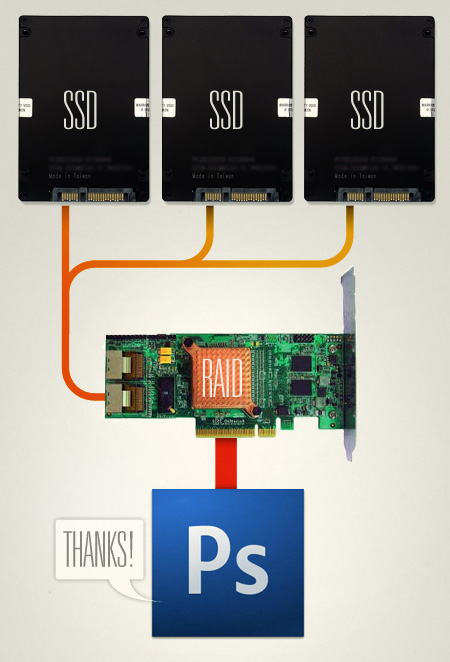
I had planned on writing an article about using RAID with Photoshop for increased swap disk performance (more on that below) a while back but decided to hold off as it seemed that the arrival of SSD (solid state drives) would be a game changer for the concept of Photoshop swap disks. The only issue with SSD’s was the price; they always seemed to hover around the $1,000 range and weren’t any faster than normal drives. But recently SSD prices have plummeted and their speeds have shot up. It seems the age of affordable SSD’s is upon us and anyone interested in speeding up their workflow should take note.
So what’s an SSD Then?
An SSD is simply a hard drive which uses flash memory — like the stuff in your digital camera — to store data instead of the old magnetic platters used in current drives. The major benefits of SSD’s are extreme reliability — 30+ years of continuous operation, silent operation — no moving parts, low operating temperature — they don’t generate any heat, and speed — very fast read/write and seek times. All of these properties make SSD’s great candidates for use as swap drives for Photoshop and other multimedia applications. In the rest of this article I will focus on the benefits of SSD and RAID (more on RAID below) specifically for Photoshop, but they can greatly increase the performance of many other applications in the Audio/Video/Design fields (think media drive for After Effects or multi-track recoding disk for Logic). The only caveat to all of this is that SSD’s have asynchronous read/write speeds. They can read data much faster than they can write it. At the time of this writing, SSD write speeds are still about the same as normal disks, read speed is where they excel. I expect this will change soon though.
The Swap Disk
If you’re not familiar with how the swap drive in Photoshop works (Edit > Preferences > Performance in CS4) here’s a quick, very rough primer: Photoshop is constantly reading and writing temporary files in the background as you work. Ideally it reads and writes this data within your computer’s super-fast RAM. But as you start to work with larger documents (e.g. full size print work @ 300dpi) it quickly fills up the RAM space and needs some place to write the overflowing information. Now, if you have 64GB of RAM in your system you can stop reading here, but for the rest of us this is where the swap drive comes in. Since your operating system is also constantly reading and writing to and from your primary hard disk, it is essential that you have a second, dedicated disk as your swap drive. This way Photoshop can have all the bandwidth of that drive all to itself. The main problem with this is that while having a drive dedicated as the swap disk will help, it will never be as fast as RAM. This is where SSD’s and RAID can start to make a huge difference in Photoshop’s performance.
RAID Zero
One SSD as your swap disk is great, but what if you could stack several together to act as a single drive with a multiplied speed? This practice is known as RAID and it’s the key to boosting disk performance. I will try to explain RAID in simple terms here as it’s a rather complex subject. For our purposes you only really need to know a few things, if you want to know more just google RAID and you can learn the ins and outs pretty quickly. There are many flavors of RAID, but the one we are concerned with is RAID 0 (that’s a zero on the end). RAID 0 essentially takes multiple drives and treats them as one, leveraging the bandwidth of each to create one virtual drive with a greater speed than each individual drive and a total size equal to all drives combined. For instance, TweakTown was able to coax a 650MB/s read speed out of four Patriot SSD’s in RAID 0 on an Areca card.
The only problem with RAID0 is that it’s not fault tolerant, if any one of the drives in a RAID0 array go down, that’s it, you lose everything on the virtual drive that represents those four disks. But this is less of an issue given the inherent stability of SSD’s and for our purposes, we don’t really care about fault tolerance. Since this is only a temporary swap drive, all the files will be deleted each time we quit Photoshop. If you want to write permanent files to a RAID array, look into RAID1 which is sort of a blend of safety and speed, but with the lifespan and stability of SSD’s, you could probably get away with RAID0 for permanent file storage.
SSD+RAID=FAST
Here’s where things get really interesting. And when I say “interesting” I mean 650MB/s of interesting. When I built my last computer I used ye olde hard drives (non-SSD) for the RAID0 array and it was still very fast. This was waaay back (2008) when even one SSD was outrageously expensive so I ruled them out as a possibility. Now you can snag a very fast SSD for under $100, here’s a good example. You might be thinking that 32GB is rather small, but remember, this is just a temporary drive so we are mostly concerned with speed and not so much the storage space. Photoshop swap files rarely (maybe never?) get anywhere near 32GB in size. And if you plan on putting multiple drives into a RAID0 configuration, size becomes even less of an issue. RAID0 drive size is the sum total of all drives in the array. If you have three 32GB drives in the array, the disk size that your operating system will “see” is 96GB of SSD goodness. I could go on explaining how fast things start to get when you strap multiple SSD’s into a RAID0 array, but this video sums it all up quite nicely. You’ll hear a lot of technical jargon so if you don’t understand it all or can’t stand watching that guy talk for more than 30 seconds, just know this: everything he is saying basically amounts to these drives being ridiculously fast and reliable, two qualities digital artists hold in high regard when it comes to hard drives.
RAID Cards
Another thing to consider in all this is how to connect the drives. Most modern motherboards come with a form of RAID built in. Unfortunately, this is usually a software driven type of RAID and so it’s more about reliability than speed. For true speed you need to get a dedicated RAID card with it’s own processor on board. I have the Highpoint RocketRAID 3520 in my system and it’s been great. There are many others (such as the the Areca cards mentioned in the video above) so dig around for the best value. RAID cards can be expensive but it’s a good investment as they deliver great performance for the price. Spending $300 extra on a more powerful CPU might net you a small margin of increased Photoshop performance, but the same money spent on a RAID card and some drives will put your benchmarks through the roof.
Moral of The Story
If you are using Photoshop for anything, you should at the very least have one dedicated drive as the swap. If you are serious about using Photoshop for print and larger file sizes, you should be running an SSD for your swap drive. If you are obsessed with Photoshop performance and are creating 24×36″ posters @ 300dpi, you should be running multiple SSD’s on a dedicated RAID0 card as your swap disk. Sure SSD is still quite new, and the price per megabyte is still quite high (relatively speaking) but the performance gains can be huge. I’m not saying run out and buy up a stack of SSD’s, but if you are considering a new system or system upgrade in the near future, SSD’s should be on your research list. All told, a solid RAID 0 setup with two to four drives will run from about $400-$700 which could net you anywhere from 400-650MB/s swap read speeds. That’s a great ROI and whether you’re running Photoshop, producing music, or doing video, RAID0 and SSD’s are well worth your consideration. The way I see it, the more speed and power at my fingertips, the faster I can work and the more I can experiment with new ways of working. My goal is always to remove as many obstacles as possible between myself and the finished product and more responsive software goes a long way to eliminate the biggest obstacle of them all: time.

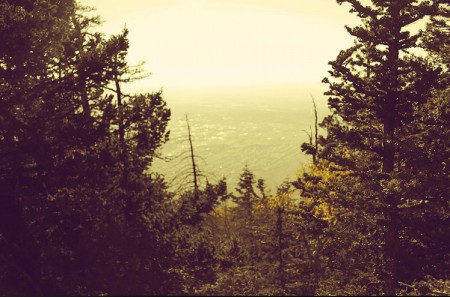


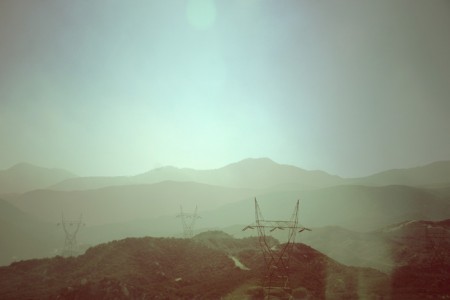
Navis has been a long time commenter on this blog but I just recently stumbled onto his photography and was very impressed. The colors are just perfect; such a nice tone, feels modern yet still authentic. From the Flickr EXIF data it looks like he’s using a Canon EOS 30D. Tim, perhaps you’d like to elaborate on your equipment (lenses etc.) and methods in the comments?
You can find more of Navis’ work at his Flickr and his portfolio.
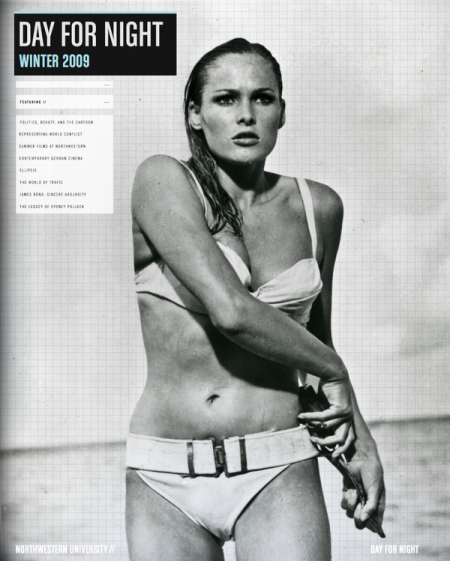
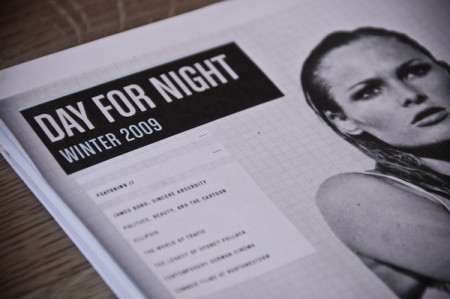
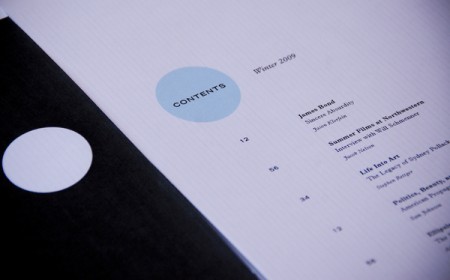
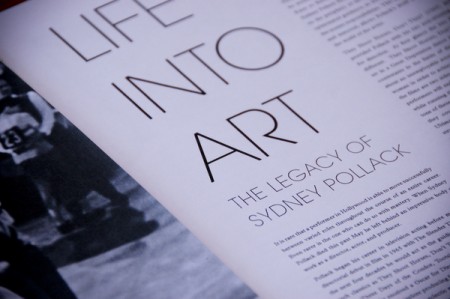
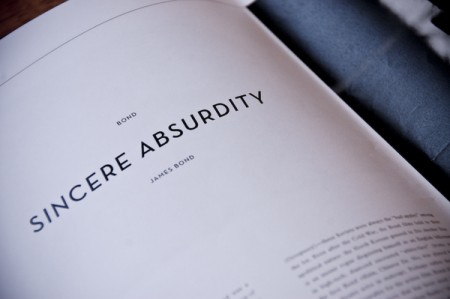
As you may already know, Alex Cornell — the same Alex who posts on this blog — is also my intern around the studio. A while back Northwestern University asked him to take on the daunting task of layout and design for their “Day For Night” magazine. The previous design was pretty much your run-of-the-mill college publication without much thought put into the design so this was a great chance for him to really evolve the visual language of the magazine. The big constraint was colors; apparently he can only use black, white, and one spot color of his choosing per issue. As you can see, the finished product is superb, Alex’s excellent eye for typography and layout really shine through in his first issue for the magazine. This project was featured (and deservedly so) by Behance last week and is up on Alex’s portfolio page there. Congrats Alex, very nice work!






